NAB's Misconduct: A Marketing Systems Analysis of the Royal Commission
VerifiedAdded on 2023/04/21
|8
|2170
|365
Case Study
AI Summary
This case study examines the National Australia Bank's (NAB) involvement in the Banking Royal Commission, analyzing the bank's misconduct and its impact from a marketing systems perspective. The report discusses the organizational background of NAB, its role within the marketing system, and the specific instances of misconduct that led to scrutiny by the Royal Commission. It incorporates the social mechanism theory and path dependency theory to explain how the bank's actions affected its customers and overall reputation. The analysis includes ways to improve the bank's structure and functioning, highlighting key opportunities and providing recommendations for NAB to rebuild trust, enhance customer satisfaction, and ensure ethical practices. The report concludes by emphasizing the importance of building healthy customer relations and leveraging technology for future growth, with remediation strategies for past misconducts.
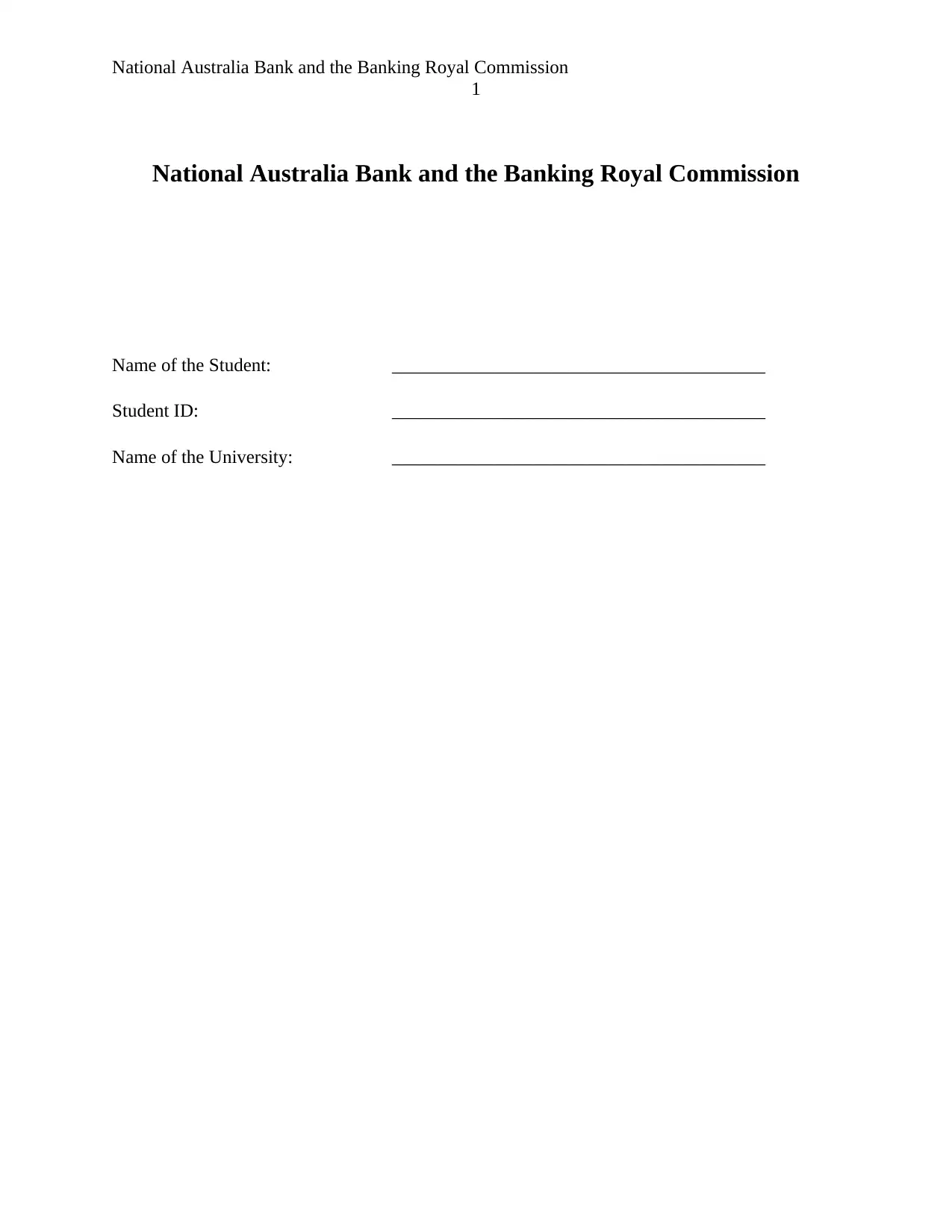
National Australia Bank and the Banking Royal Commission
1
National Australia Bank and the Banking Royal Commission
Name of the Student: ________________________________________
Student ID: ________________________________________
Name of the University: ________________________________________
1
National Australia Bank and the Banking Royal Commission
Name of the Student: ________________________________________
Student ID: ________________________________________
Name of the University: ________________________________________
Paraphrase This Document
Need a fresh take? Get an instant paraphrase of this document with our AI Paraphraser
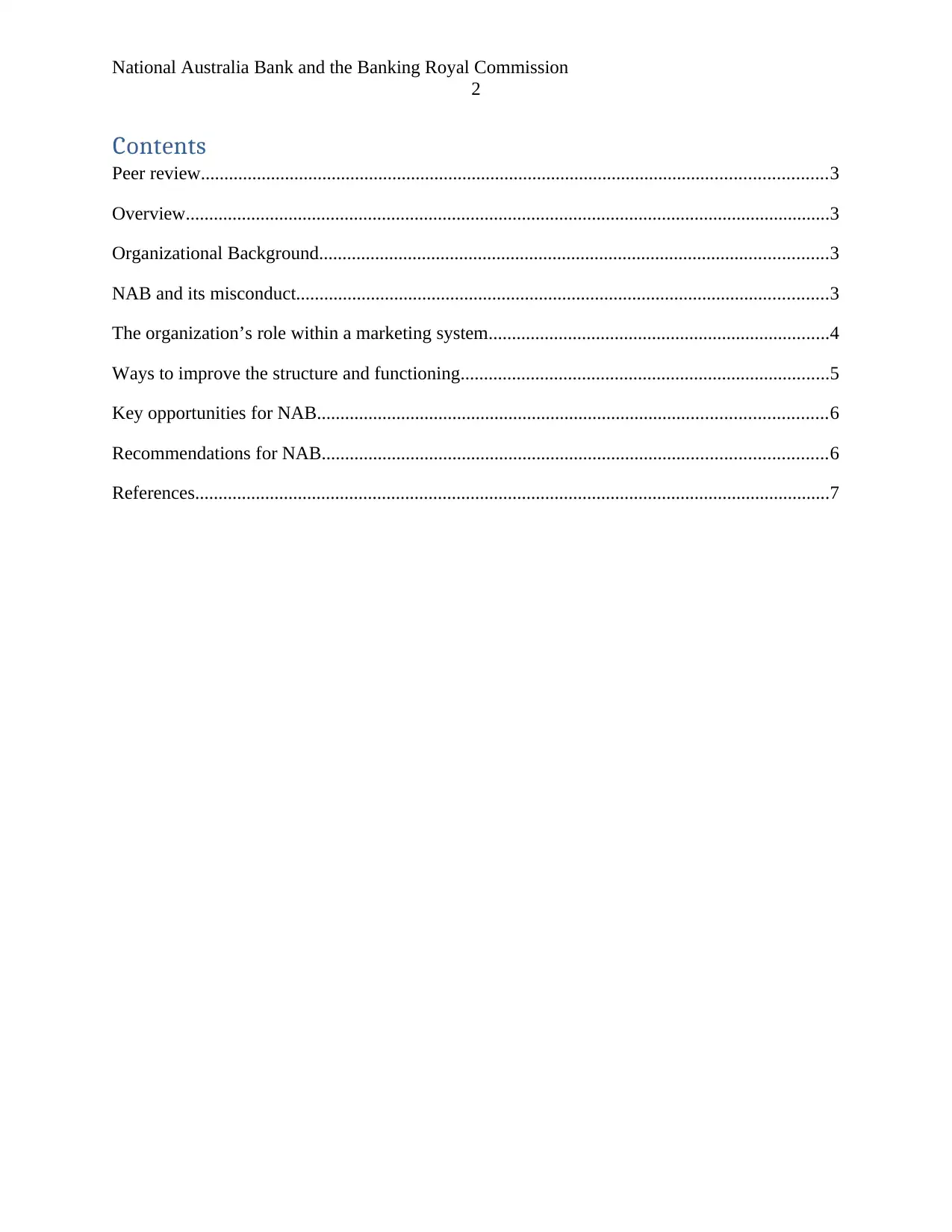
National Australia Bank and the Banking Royal Commission
2
Contents
Peer review......................................................................................................................................3
Overview..........................................................................................................................................3
Organizational Background.............................................................................................................3
NAB and its misconduct..................................................................................................................3
The organization’s role within a marketing system.........................................................................4
Ways to improve the structure and functioning...............................................................................5
Key opportunities for NAB.............................................................................................................6
Recommendations for NAB............................................................................................................6
References........................................................................................................................................7
2
Contents
Peer review......................................................................................................................................3
Overview..........................................................................................................................................3
Organizational Background.............................................................................................................3
NAB and its misconduct..................................................................................................................3
The organization’s role within a marketing system.........................................................................4
Ways to improve the structure and functioning...............................................................................5
Key opportunities for NAB.............................................................................................................6
Recommendations for NAB............................................................................................................6
References........................................................................................................................................7
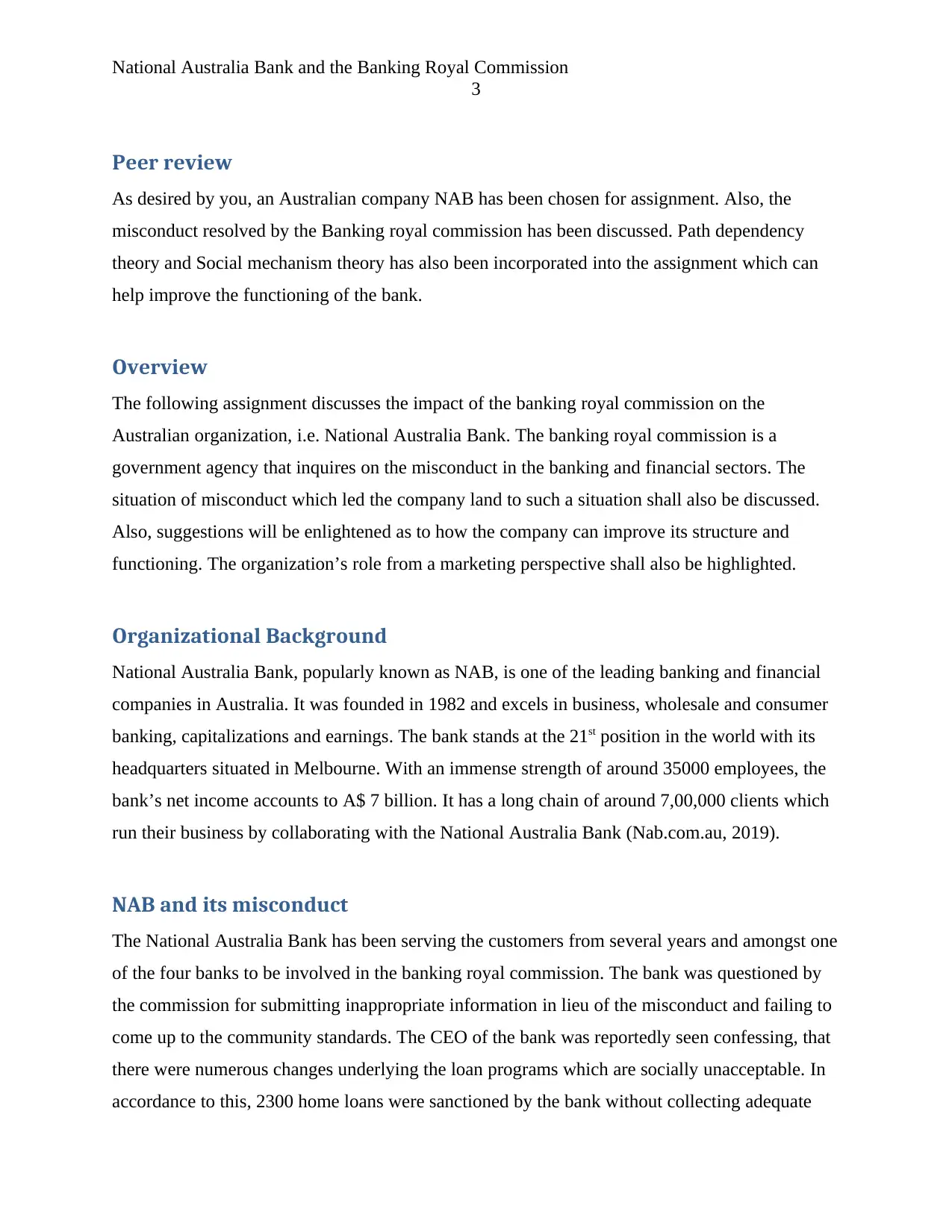
National Australia Bank and the Banking Royal Commission
3
Peer review
As desired by you, an Australian company NAB has been chosen for assignment. Also, the
misconduct resolved by the Banking royal commission has been discussed. Path dependency
theory and Social mechanism theory has also been incorporated into the assignment which can
help improve the functioning of the bank.
Overview
The following assignment discusses the impact of the banking royal commission on the
Australian organization, i.e. National Australia Bank. The banking royal commission is a
government agency that inquires on the misconduct in the banking and financial sectors. The
situation of misconduct which led the company land to such a situation shall also be discussed.
Also, suggestions will be enlightened as to how the company can improve its structure and
functioning. The organization’s role from a marketing perspective shall also be highlighted.
Organizational Background
National Australia Bank, popularly known as NAB, is one of the leading banking and financial
companies in Australia. It was founded in 1982 and excels in business, wholesale and consumer
banking, capitalizations and earnings. The bank stands at the 21st position in the world with its
headquarters situated in Melbourne. With an immense strength of around 35000 employees, the
bank’s net income accounts to A$ 7 billion. It has a long chain of around 7,00,000 clients which
run their business by collaborating with the National Australia Bank (Nab.com.au, 2019).
NAB and its misconduct
The National Australia Bank has been serving the customers from several years and amongst one
of the four banks to be involved in the banking royal commission. The bank was questioned by
the commission for submitting inappropriate information in lieu of the misconduct and failing to
come up to the community standards. The CEO of the bank was reportedly seen confessing, that
there were numerous changes underlying the loan programs which are socially unacceptable. In
accordance to this, 2300 home loans were sanctioned by the bank without collecting adequate
3
Peer review
As desired by you, an Australian company NAB has been chosen for assignment. Also, the
misconduct resolved by the Banking royal commission has been discussed. Path dependency
theory and Social mechanism theory has also been incorporated into the assignment which can
help improve the functioning of the bank.
Overview
The following assignment discusses the impact of the banking royal commission on the
Australian organization, i.e. National Australia Bank. The banking royal commission is a
government agency that inquires on the misconduct in the banking and financial sectors. The
situation of misconduct which led the company land to such a situation shall also be discussed.
Also, suggestions will be enlightened as to how the company can improve its structure and
functioning. The organization’s role from a marketing perspective shall also be highlighted.
Organizational Background
National Australia Bank, popularly known as NAB, is one of the leading banking and financial
companies in Australia. It was founded in 1982 and excels in business, wholesale and consumer
banking, capitalizations and earnings. The bank stands at the 21st position in the world with its
headquarters situated in Melbourne. With an immense strength of around 35000 employees, the
bank’s net income accounts to A$ 7 billion. It has a long chain of around 7,00,000 clients which
run their business by collaborating with the National Australia Bank (Nab.com.au, 2019).
NAB and its misconduct
The National Australia Bank has been serving the customers from several years and amongst one
of the four banks to be involved in the banking royal commission. The bank was questioned by
the commission for submitting inappropriate information in lieu of the misconduct and failing to
come up to the community standards. The CEO of the bank was reportedly seen confessing, that
there were numerous changes underlying the loan programs which are socially unacceptable. In
accordance to this, 2300 home loans were sanctioned by the bank without collecting adequate
⊘ This is a preview!⊘
Do you want full access?
Subscribe today to unlock all pages.

Trusted by 1+ million students worldwide
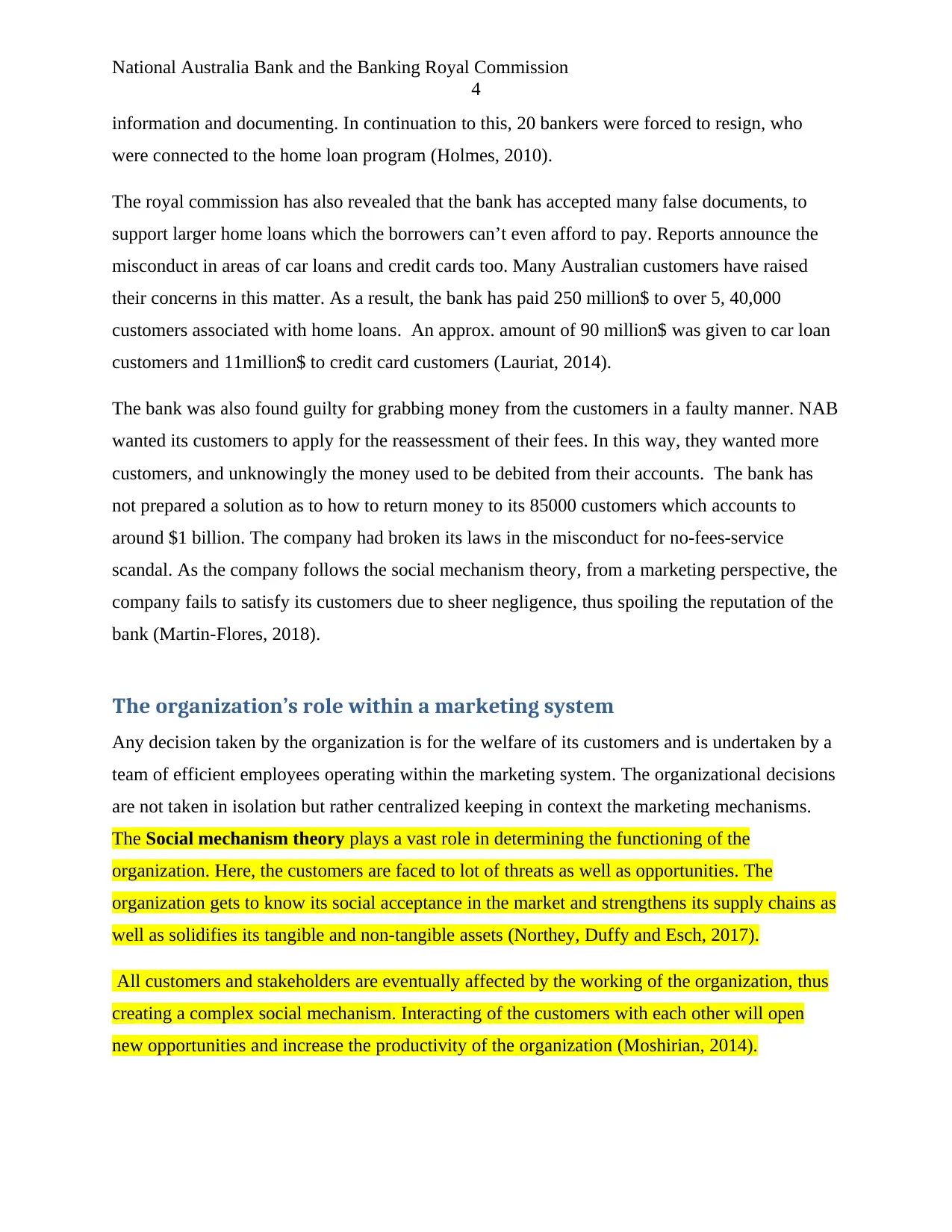
National Australia Bank and the Banking Royal Commission
4
information and documenting. In continuation to this, 20 bankers were forced to resign, who
were connected to the home loan program (Holmes, 2010).
The royal commission has also revealed that the bank has accepted many false documents, to
support larger home loans which the borrowers can’t even afford to pay. Reports announce the
misconduct in areas of car loans and credit cards too. Many Australian customers have raised
their concerns in this matter. As a result, the bank has paid 250 million$ to over 5, 40,000
customers associated with home loans. An approx. amount of 90 million$ was given to car loan
customers and 11million$ to credit card customers (Lauriat, 2014).
The bank was also found guilty for grabbing money from the customers in a faulty manner. NAB
wanted its customers to apply for the reassessment of their fees. In this way, they wanted more
customers, and unknowingly the money used to be debited from their accounts. The bank has
not prepared a solution as to how to return money to its 85000 customers which accounts to
around $1 billion. The company had broken its laws in the misconduct for no-fees-service
scandal. As the company follows the social mechanism theory, from a marketing perspective, the
company fails to satisfy its customers due to sheer negligence, thus spoiling the reputation of the
bank (Martin-Flores, 2018).
The organization’s role within a marketing system
Any decision taken by the organization is for the welfare of its customers and is undertaken by a
team of efficient employees operating within the marketing system. The organizational decisions
are not taken in isolation but rather centralized keeping in context the marketing mechanisms.
The Social mechanism theory plays a vast role in determining the functioning of the
organization. Here, the customers are faced to lot of threats as well as opportunities. The
organization gets to know its social acceptance in the market and strengthens its supply chains as
well as solidifies its tangible and non-tangible assets (Northey, Duffy and Esch, 2017).
All customers and stakeholders are eventually affected by the working of the organization, thus
creating a complex social mechanism. Interacting of the customers with each other will open
new opportunities and increase the productivity of the organization (Moshirian, 2014).
4
information and documenting. In continuation to this, 20 bankers were forced to resign, who
were connected to the home loan program (Holmes, 2010).
The royal commission has also revealed that the bank has accepted many false documents, to
support larger home loans which the borrowers can’t even afford to pay. Reports announce the
misconduct in areas of car loans and credit cards too. Many Australian customers have raised
their concerns in this matter. As a result, the bank has paid 250 million$ to over 5, 40,000
customers associated with home loans. An approx. amount of 90 million$ was given to car loan
customers and 11million$ to credit card customers (Lauriat, 2014).
The bank was also found guilty for grabbing money from the customers in a faulty manner. NAB
wanted its customers to apply for the reassessment of their fees. In this way, they wanted more
customers, and unknowingly the money used to be debited from their accounts. The bank has
not prepared a solution as to how to return money to its 85000 customers which accounts to
around $1 billion. The company had broken its laws in the misconduct for no-fees-service
scandal. As the company follows the social mechanism theory, from a marketing perspective, the
company fails to satisfy its customers due to sheer negligence, thus spoiling the reputation of the
bank (Martin-Flores, 2018).
The organization’s role within a marketing system
Any decision taken by the organization is for the welfare of its customers and is undertaken by a
team of efficient employees operating within the marketing system. The organizational decisions
are not taken in isolation but rather centralized keeping in context the marketing mechanisms.
The Social mechanism theory plays a vast role in determining the functioning of the
organization. Here, the customers are faced to lot of threats as well as opportunities. The
organization gets to know its social acceptance in the market and strengthens its supply chains as
well as solidifies its tangible and non-tangible assets (Northey, Duffy and Esch, 2017).
All customers and stakeholders are eventually affected by the working of the organization, thus
creating a complex social mechanism. Interacting of the customers with each other will open
new opportunities and increase the productivity of the organization (Moshirian, 2014).
Paraphrase This Document
Need a fresh take? Get an instant paraphrase of this document with our AI Paraphraser
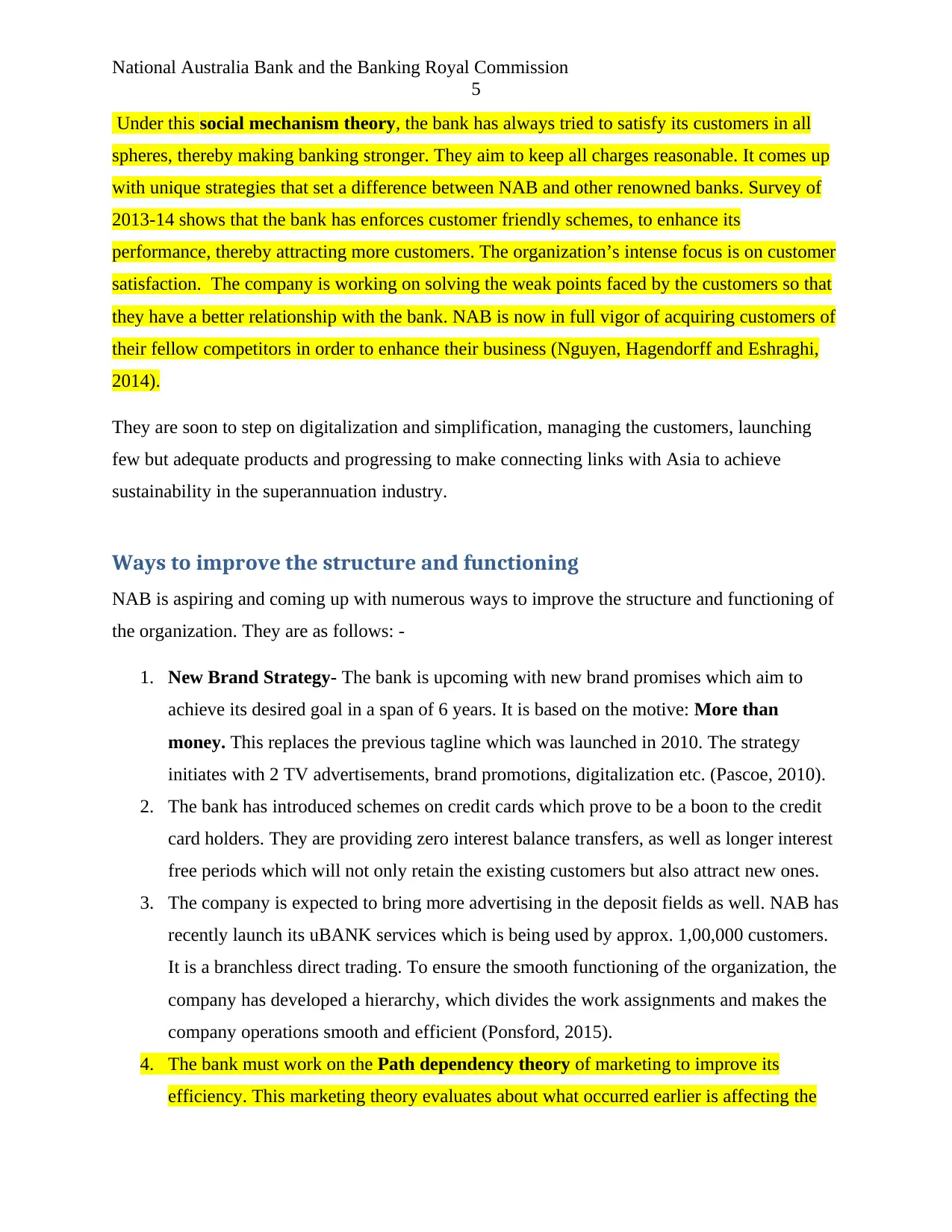
National Australia Bank and the Banking Royal Commission
5
Under this social mechanism theory, the bank has always tried to satisfy its customers in all
spheres, thereby making banking stronger. They aim to keep all charges reasonable. It comes up
with unique strategies that set a difference between NAB and other renowned banks. Survey of
2013-14 shows that the bank has enforces customer friendly schemes, to enhance its
performance, thereby attracting more customers. The organization’s intense focus is on customer
satisfaction. The company is working on solving the weak points faced by the customers so that
they have a better relationship with the bank. NAB is now in full vigor of acquiring customers of
their fellow competitors in order to enhance their business (Nguyen, Hagendorff and Eshraghi,
2014).
They are soon to step on digitalization and simplification, managing the customers, launching
few but adequate products and progressing to make connecting links with Asia to achieve
sustainability in the superannuation industry.
Ways to improve the structure and functioning
NAB is aspiring and coming up with numerous ways to improve the structure and functioning of
the organization. They are as follows: -
1. New Brand Strategy- The bank is upcoming with new brand promises which aim to
achieve its desired goal in a span of 6 years. It is based on the motive: More than
money. This replaces the previous tagline which was launched in 2010. The strategy
initiates with 2 TV advertisements, brand promotions, digitalization etc. (Pascoe, 2010).
2. The bank has introduced schemes on credit cards which prove to be a boon to the credit
card holders. They are providing zero interest balance transfers, as well as longer interest
free periods which will not only retain the existing customers but also attract new ones.
3. The company is expected to bring more advertising in the deposit fields as well. NAB has
recently launch its uBANK services which is being used by approx. 1,00,000 customers.
It is a branchless direct trading. To ensure the smooth functioning of the organization, the
company has developed a hierarchy, which divides the work assignments and makes the
company operations smooth and efficient (Ponsford, 2015).
4. The bank must work on the Path dependency theory of marketing to improve its
efficiency. This marketing theory evaluates about what occurred earlier is affecting the
5
Under this social mechanism theory, the bank has always tried to satisfy its customers in all
spheres, thereby making banking stronger. They aim to keep all charges reasonable. It comes up
with unique strategies that set a difference between NAB and other renowned banks. Survey of
2013-14 shows that the bank has enforces customer friendly schemes, to enhance its
performance, thereby attracting more customers. The organization’s intense focus is on customer
satisfaction. The company is working on solving the weak points faced by the customers so that
they have a better relationship with the bank. NAB is now in full vigor of acquiring customers of
their fellow competitors in order to enhance their business (Nguyen, Hagendorff and Eshraghi,
2014).
They are soon to step on digitalization and simplification, managing the customers, launching
few but adequate products and progressing to make connecting links with Asia to achieve
sustainability in the superannuation industry.
Ways to improve the structure and functioning
NAB is aspiring and coming up with numerous ways to improve the structure and functioning of
the organization. They are as follows: -
1. New Brand Strategy- The bank is upcoming with new brand promises which aim to
achieve its desired goal in a span of 6 years. It is based on the motive: More than
money. This replaces the previous tagline which was launched in 2010. The strategy
initiates with 2 TV advertisements, brand promotions, digitalization etc. (Pascoe, 2010).
2. The bank has introduced schemes on credit cards which prove to be a boon to the credit
card holders. They are providing zero interest balance transfers, as well as longer interest
free periods which will not only retain the existing customers but also attract new ones.
3. The company is expected to bring more advertising in the deposit fields as well. NAB has
recently launch its uBANK services which is being used by approx. 1,00,000 customers.
It is a branchless direct trading. To ensure the smooth functioning of the organization, the
company has developed a hierarchy, which divides the work assignments and makes the
company operations smooth and efficient (Ponsford, 2015).
4. The bank must work on the Path dependency theory of marketing to improve its
efficiency. This marketing theory evaluates about what occurred earlier is affecting the
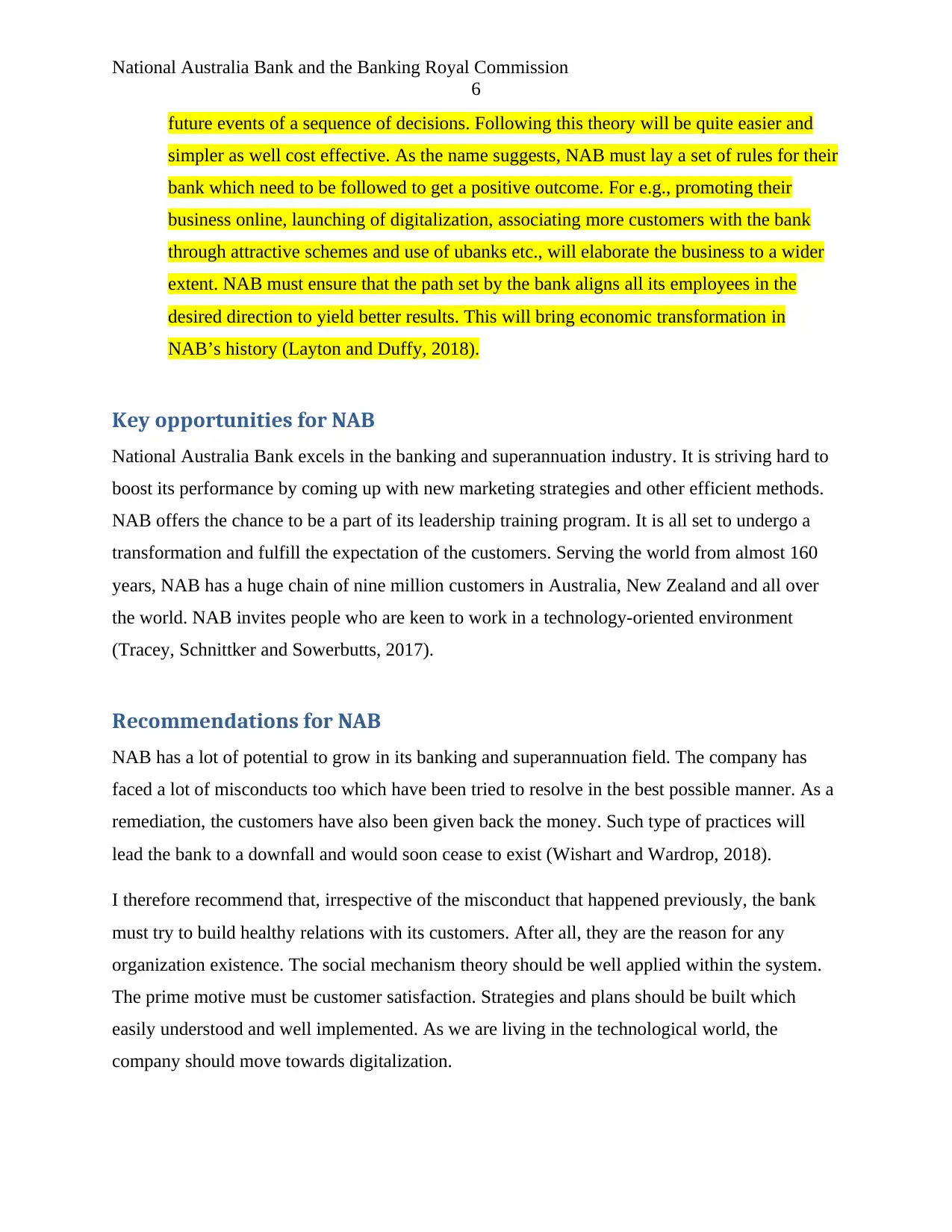
National Australia Bank and the Banking Royal Commission
6
future events of a sequence of decisions. Following this theory will be quite easier and
simpler as well cost effective. As the name suggests, NAB must lay a set of rules for their
bank which need to be followed to get a positive outcome. For e.g., promoting their
business online, launching of digitalization, associating more customers with the bank
through attractive schemes and use of ubanks etc., will elaborate the business to a wider
extent. NAB must ensure that the path set by the bank aligns all its employees in the
desired direction to yield better results. This will bring economic transformation in
NAB’s history (Layton and Duffy, 2018).
Key opportunities for NAB
National Australia Bank excels in the banking and superannuation industry. It is striving hard to
boost its performance by coming up with new marketing strategies and other efficient methods.
NAB offers the chance to be a part of its leadership training program. It is all set to undergo a
transformation and fulfill the expectation of the customers. Serving the world from almost 160
years, NAB has a huge chain of nine million customers in Australia, New Zealand and all over
the world. NAB invites people who are keen to work in a technology-oriented environment
(Tracey, Schnittker and Sowerbutts, 2017).
Recommendations for NAB
NAB has a lot of potential to grow in its banking and superannuation field. The company has
faced a lot of misconducts too which have been tried to resolve in the best possible manner. As a
remediation, the customers have also been given back the money. Such type of practices will
lead the bank to a downfall and would soon cease to exist (Wishart and Wardrop, 2018).
I therefore recommend that, irrespective of the misconduct that happened previously, the bank
must try to build healthy relations with its customers. After all, they are the reason for any
organization existence. The social mechanism theory should be well applied within the system.
The prime motive must be customer satisfaction. Strategies and plans should be built which
easily understood and well implemented. As we are living in the technological world, the
company should move towards digitalization.
6
future events of a sequence of decisions. Following this theory will be quite easier and
simpler as well cost effective. As the name suggests, NAB must lay a set of rules for their
bank which need to be followed to get a positive outcome. For e.g., promoting their
business online, launching of digitalization, associating more customers with the bank
through attractive schemes and use of ubanks etc., will elaborate the business to a wider
extent. NAB must ensure that the path set by the bank aligns all its employees in the
desired direction to yield better results. This will bring economic transformation in
NAB’s history (Layton and Duffy, 2018).
Key opportunities for NAB
National Australia Bank excels in the banking and superannuation industry. It is striving hard to
boost its performance by coming up with new marketing strategies and other efficient methods.
NAB offers the chance to be a part of its leadership training program. It is all set to undergo a
transformation and fulfill the expectation of the customers. Serving the world from almost 160
years, NAB has a huge chain of nine million customers in Australia, New Zealand and all over
the world. NAB invites people who are keen to work in a technology-oriented environment
(Tracey, Schnittker and Sowerbutts, 2017).
Recommendations for NAB
NAB has a lot of potential to grow in its banking and superannuation field. The company has
faced a lot of misconducts too which have been tried to resolve in the best possible manner. As a
remediation, the customers have also been given back the money. Such type of practices will
lead the bank to a downfall and would soon cease to exist (Wishart and Wardrop, 2018).
I therefore recommend that, irrespective of the misconduct that happened previously, the bank
must try to build healthy relations with its customers. After all, they are the reason for any
organization existence. The social mechanism theory should be well applied within the system.
The prime motive must be customer satisfaction. Strategies and plans should be built which
easily understood and well implemented. As we are living in the technological world, the
company should move towards digitalization.
⊘ This is a preview!⊘
Do you want full access?
Subscribe today to unlock all pages.

Trusted by 1+ million students worldwide
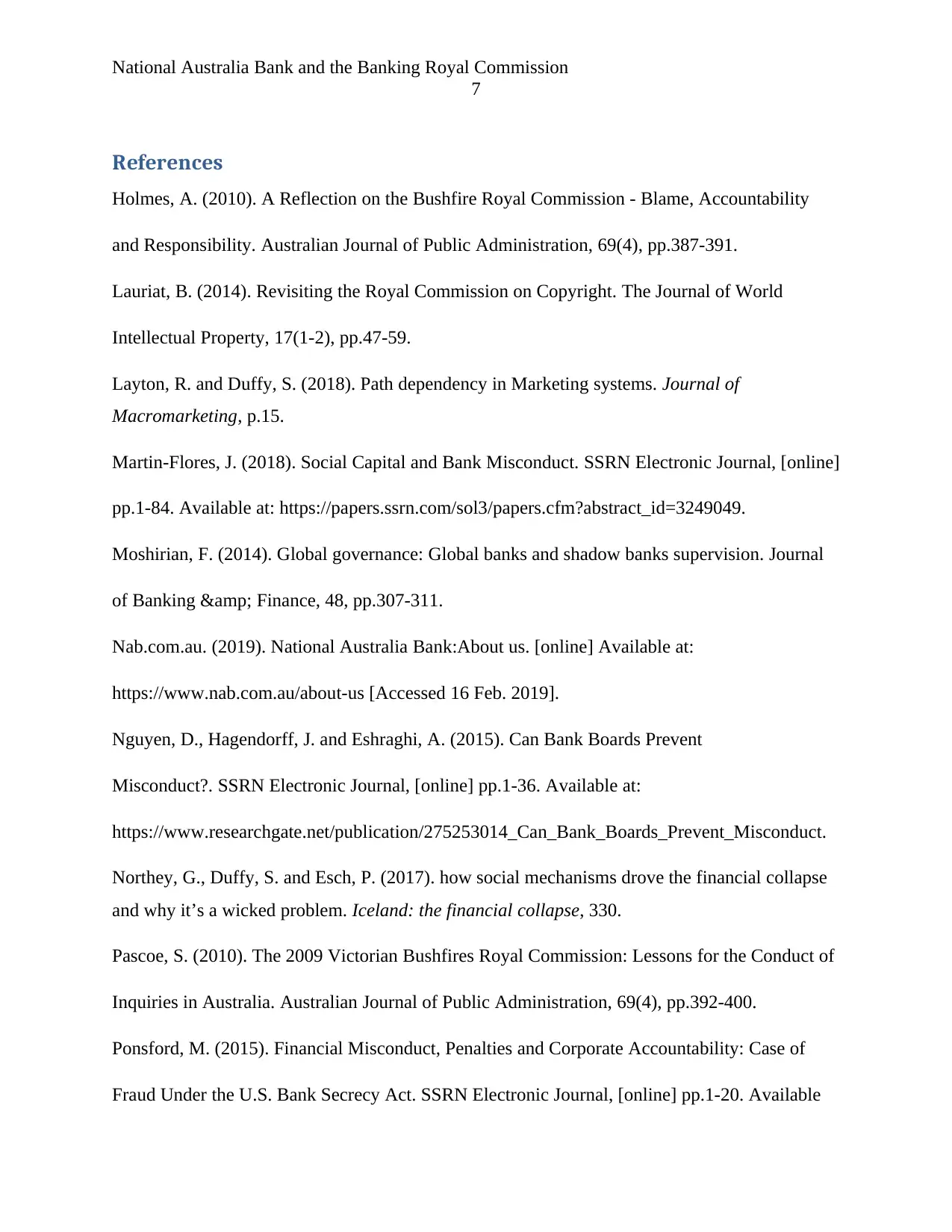
National Australia Bank and the Banking Royal Commission
7
References
Holmes, A. (2010). A Reflection on the Bushfire Royal Commission - Blame, Accountability
and Responsibility. Australian Journal of Public Administration, 69(4), pp.387-391.
Lauriat, B. (2014). Revisiting the Royal Commission on Copyright. The Journal of World
Intellectual Property, 17(1-2), pp.47-59.
Layton, R. and Duffy, S. (2018). Path dependency in Marketing systems. Journal of
Macromarketing, p.15.
Martin-Flores, J. (2018). Social Capital and Bank Misconduct. SSRN Electronic Journal, [online]
pp.1-84. Available at: https://papers.ssrn.com/sol3/papers.cfm?abstract_id=3249049.
Moshirian, F. (2014). Global governance: Global banks and shadow banks supervision. Journal
of Banking & Finance, 48, pp.307-311.
Nab.com.au. (2019). National Australia Bank:About us. [online] Available at:
https://www.nab.com.au/about-us [Accessed 16 Feb. 2019].
Nguyen, D., Hagendorff, J. and Eshraghi, A. (2015). Can Bank Boards Prevent
Misconduct?. SSRN Electronic Journal, [online] pp.1-36. Available at:
https://www.researchgate.net/publication/275253014_Can_Bank_Boards_Prevent_Misconduct.
Northey, G., Duffy, S. and Esch, P. (2017). how social mechanisms drove the financial collapse
and why it’s a wicked problem. Iceland: the financial collapse, 330.
Pascoe, S. (2010). The 2009 Victorian Bushfires Royal Commission: Lessons for the Conduct of
Inquiries in Australia. Australian Journal of Public Administration, 69(4), pp.392-400.
Ponsford, M. (2015). Financial Misconduct, Penalties and Corporate Accountability: Case of
Fraud Under the U.S. Bank Secrecy Act. SSRN Electronic Journal, [online] pp.1-20. Available
7
References
Holmes, A. (2010). A Reflection on the Bushfire Royal Commission - Blame, Accountability
and Responsibility. Australian Journal of Public Administration, 69(4), pp.387-391.
Lauriat, B. (2014). Revisiting the Royal Commission on Copyright. The Journal of World
Intellectual Property, 17(1-2), pp.47-59.
Layton, R. and Duffy, S. (2018). Path dependency in Marketing systems. Journal of
Macromarketing, p.15.
Martin-Flores, J. (2018). Social Capital and Bank Misconduct. SSRN Electronic Journal, [online]
pp.1-84. Available at: https://papers.ssrn.com/sol3/papers.cfm?abstract_id=3249049.
Moshirian, F. (2014). Global governance: Global banks and shadow banks supervision. Journal
of Banking & Finance, 48, pp.307-311.
Nab.com.au. (2019). National Australia Bank:About us. [online] Available at:
https://www.nab.com.au/about-us [Accessed 16 Feb. 2019].
Nguyen, D., Hagendorff, J. and Eshraghi, A. (2015). Can Bank Boards Prevent
Misconduct?. SSRN Electronic Journal, [online] pp.1-36. Available at:
https://www.researchgate.net/publication/275253014_Can_Bank_Boards_Prevent_Misconduct.
Northey, G., Duffy, S. and Esch, P. (2017). how social mechanisms drove the financial collapse
and why it’s a wicked problem. Iceland: the financial collapse, 330.
Pascoe, S. (2010). The 2009 Victorian Bushfires Royal Commission: Lessons for the Conduct of
Inquiries in Australia. Australian Journal of Public Administration, 69(4), pp.392-400.
Ponsford, M. (2015). Financial Misconduct, Penalties and Corporate Accountability: Case of
Fraud Under the U.S. Bank Secrecy Act. SSRN Electronic Journal, [online] pp.1-20. Available
Paraphrase This Document
Need a fresh take? Get an instant paraphrase of this document with our AI Paraphraser
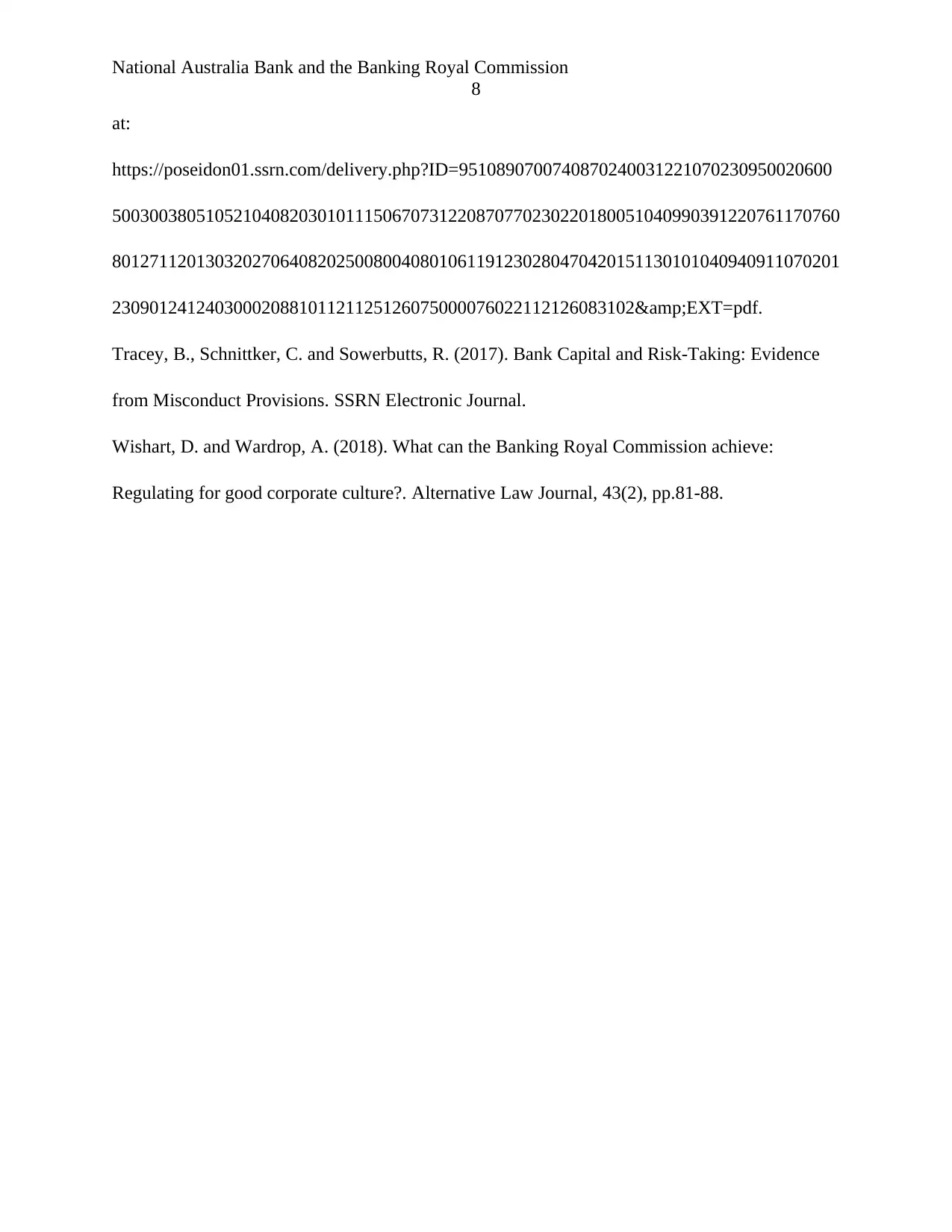
National Australia Bank and the Banking Royal Commission
8
at:
https://poseidon01.ssrn.com/delivery.php?ID=9510890700740870240031221070230950020600
500300380510521040820301011150670731220870770230220180051040990391220761170760
801271120130320270640820250080040801061191230280470420151130101040940911070201
23090124124030002088101121125126075000076022112126083102&EXT=pdf.
Tracey, B., Schnittker, C. and Sowerbutts, R. (2017). Bank Capital and Risk-Taking: Evidence
from Misconduct Provisions. SSRN Electronic Journal.
Wishart, D. and Wardrop, A. (2018). What can the Banking Royal Commission achieve:
Regulating for good corporate culture?. Alternative Law Journal, 43(2), pp.81-88.
8
at:
https://poseidon01.ssrn.com/delivery.php?ID=9510890700740870240031221070230950020600
500300380510521040820301011150670731220870770230220180051040990391220761170760
801271120130320270640820250080040801061191230280470420151130101040940911070201
23090124124030002088101121125126075000076022112126083102&EXT=pdf.
Tracey, B., Schnittker, C. and Sowerbutts, R. (2017). Bank Capital and Risk-Taking: Evidence
from Misconduct Provisions. SSRN Electronic Journal.
Wishart, D. and Wardrop, A. (2018). What can the Banking Royal Commission achieve:
Regulating for good corporate culture?. Alternative Law Journal, 43(2), pp.81-88.
1 out of 8
Related Documents
Your All-in-One AI-Powered Toolkit for Academic Success.
+13062052269
info@desklib.com
Available 24*7 on WhatsApp / Email
![[object Object]](/_next/static/media/star-bottom.7253800d.svg)
Unlock your academic potential
Copyright © 2020–2025 A2Z Services. All Rights Reserved. Developed and managed by ZUCOL.



